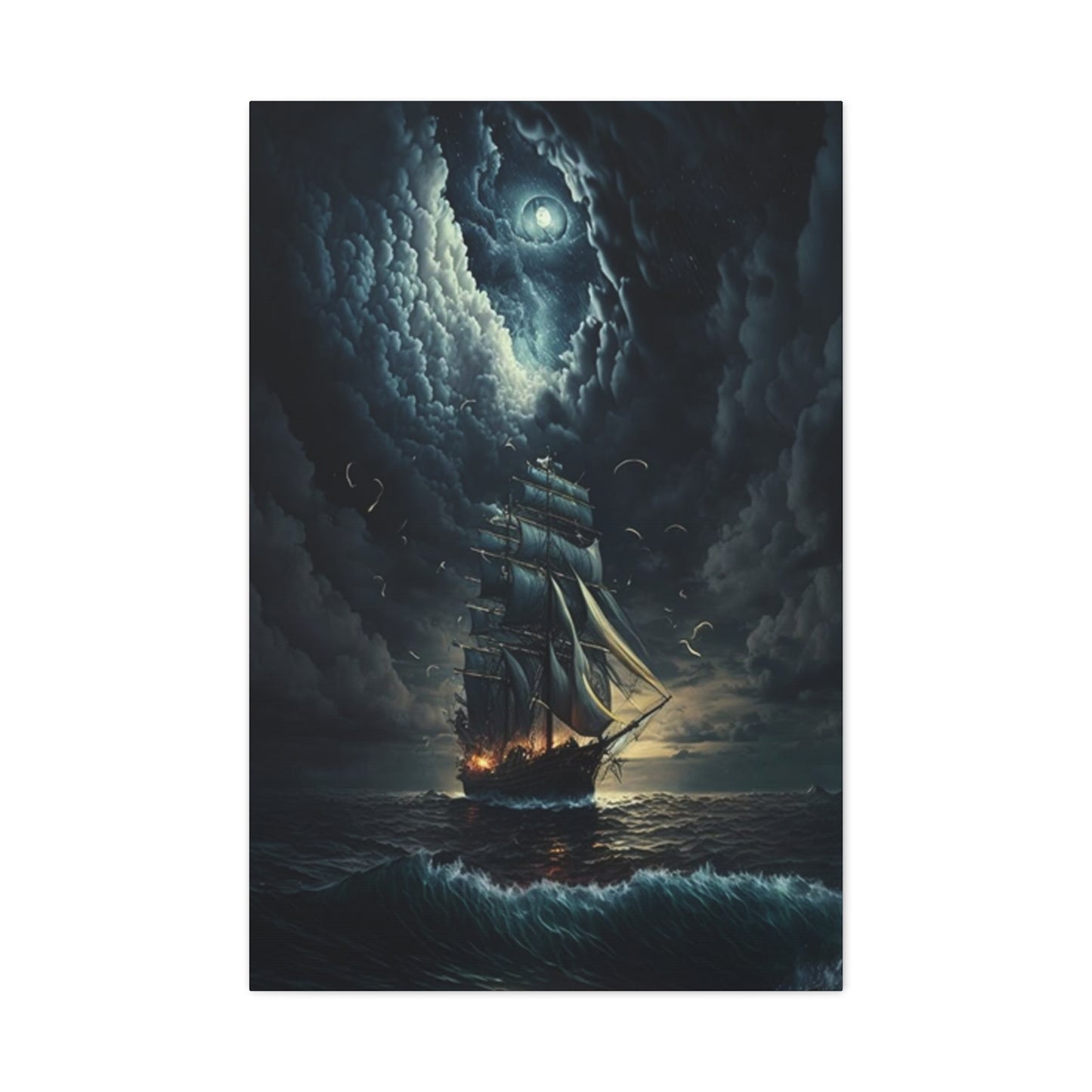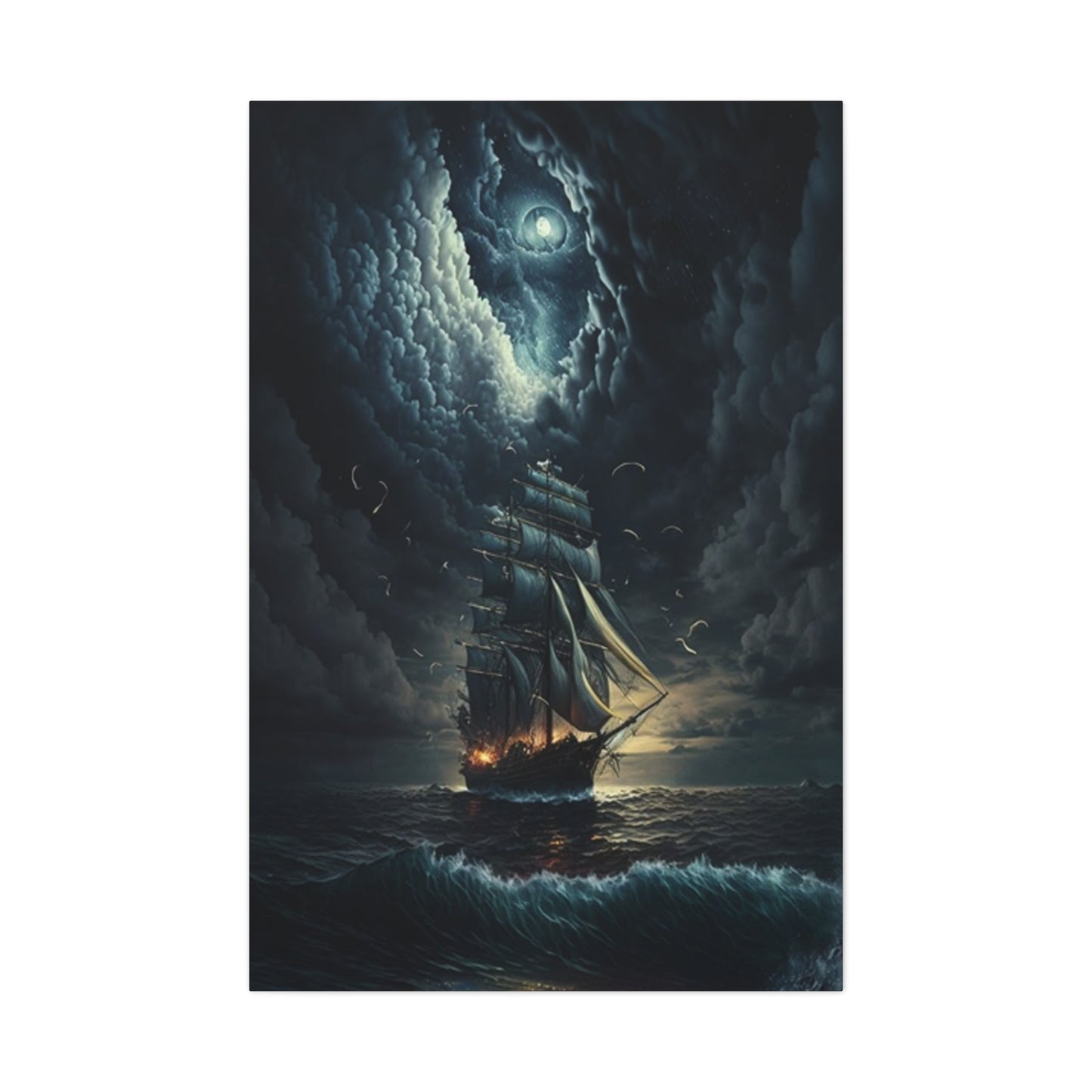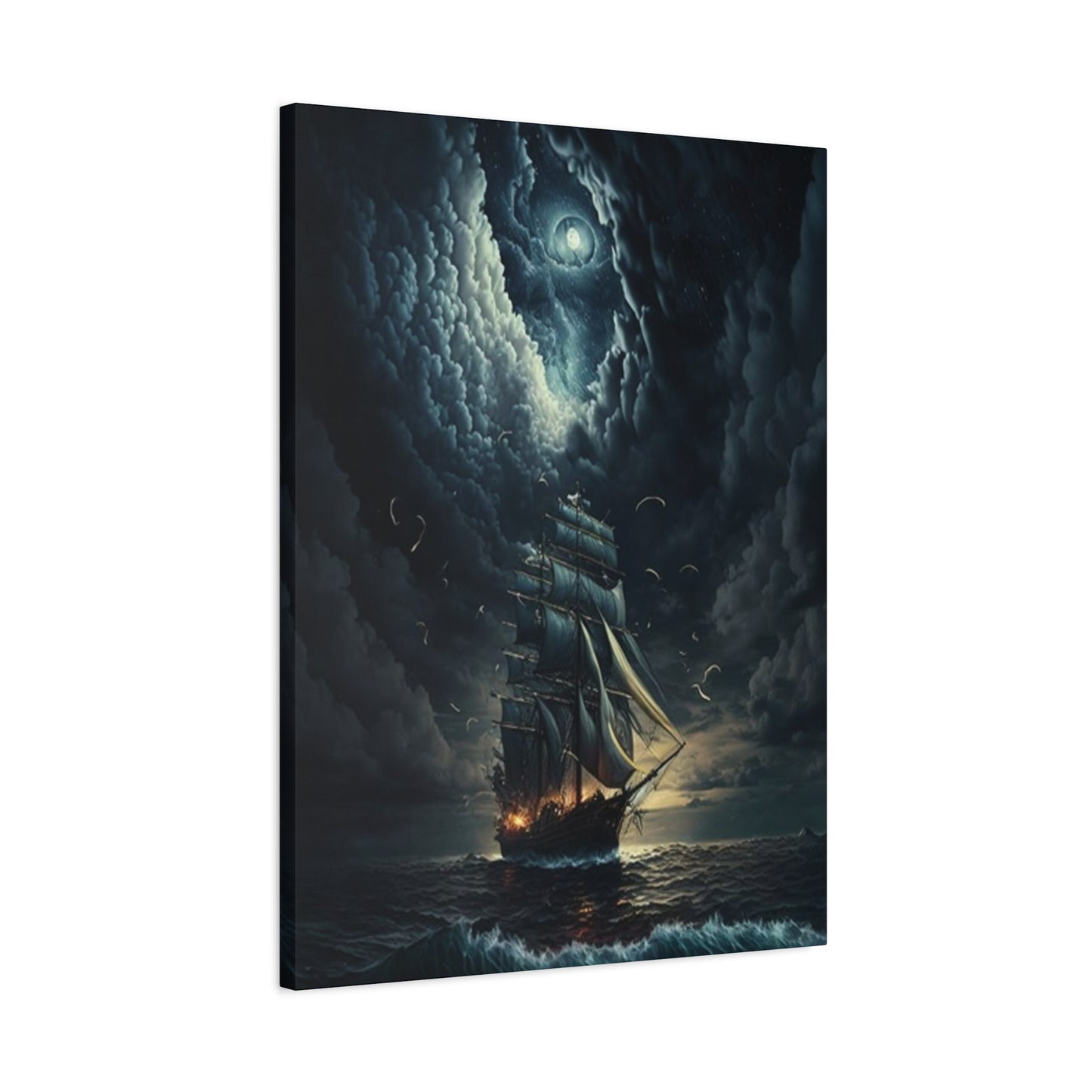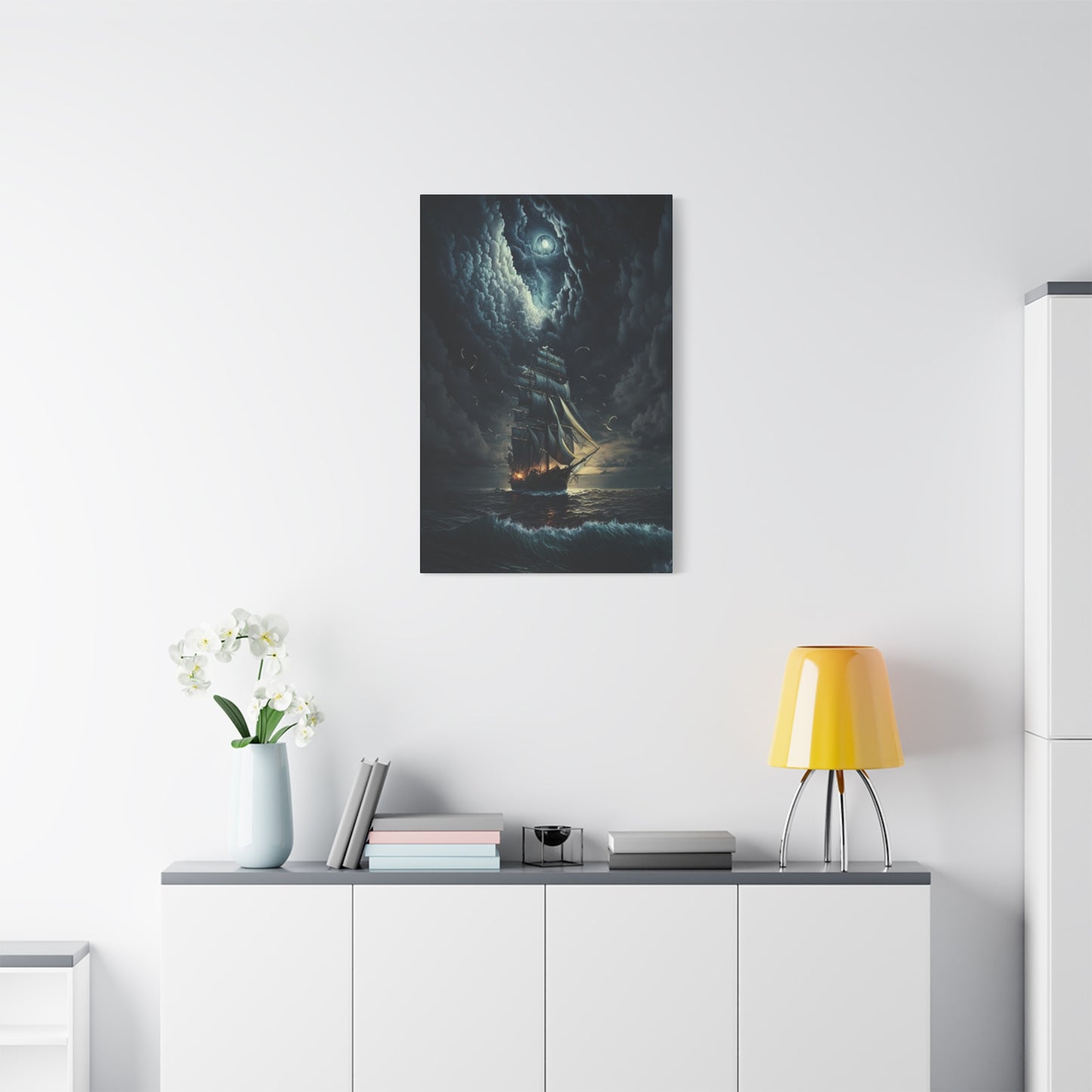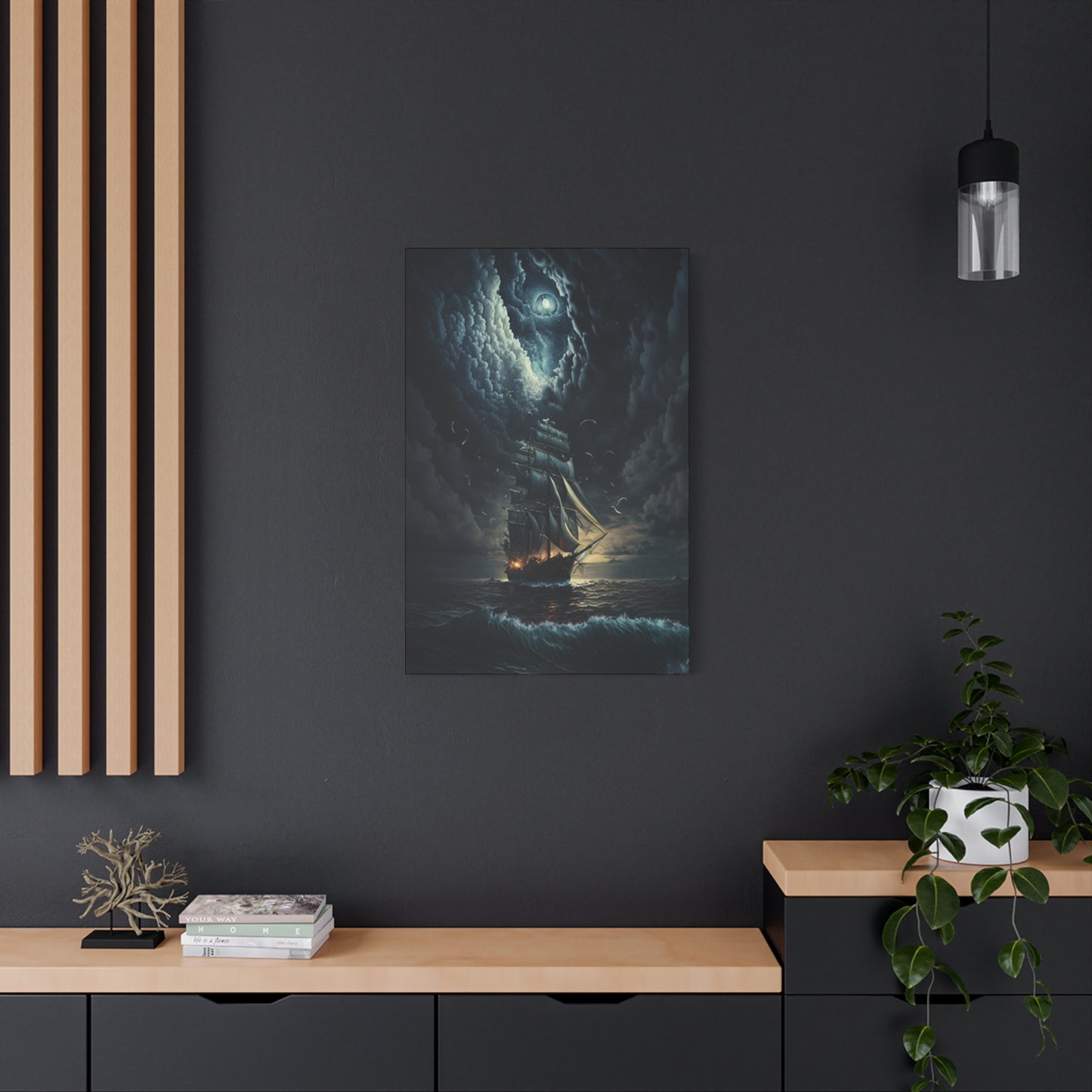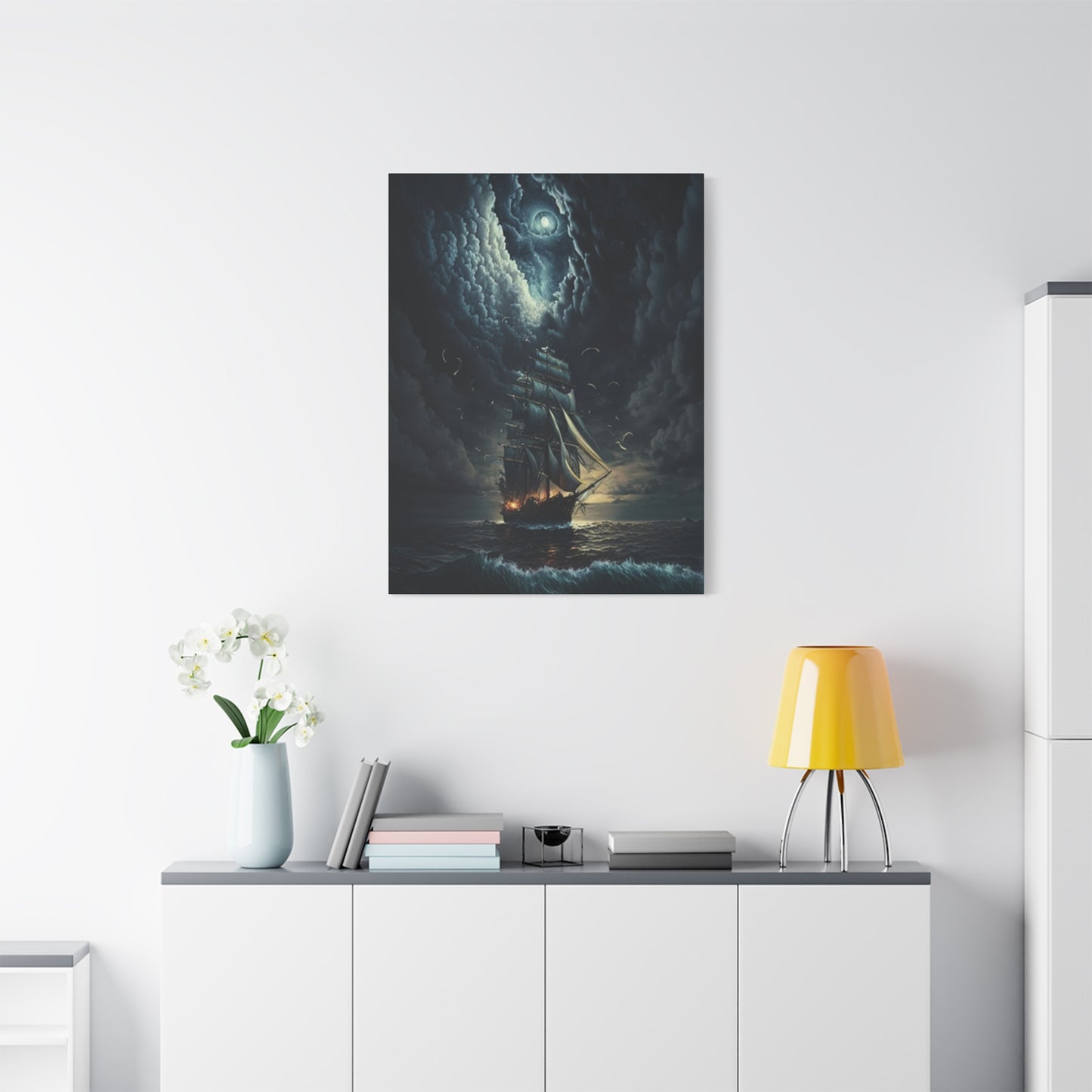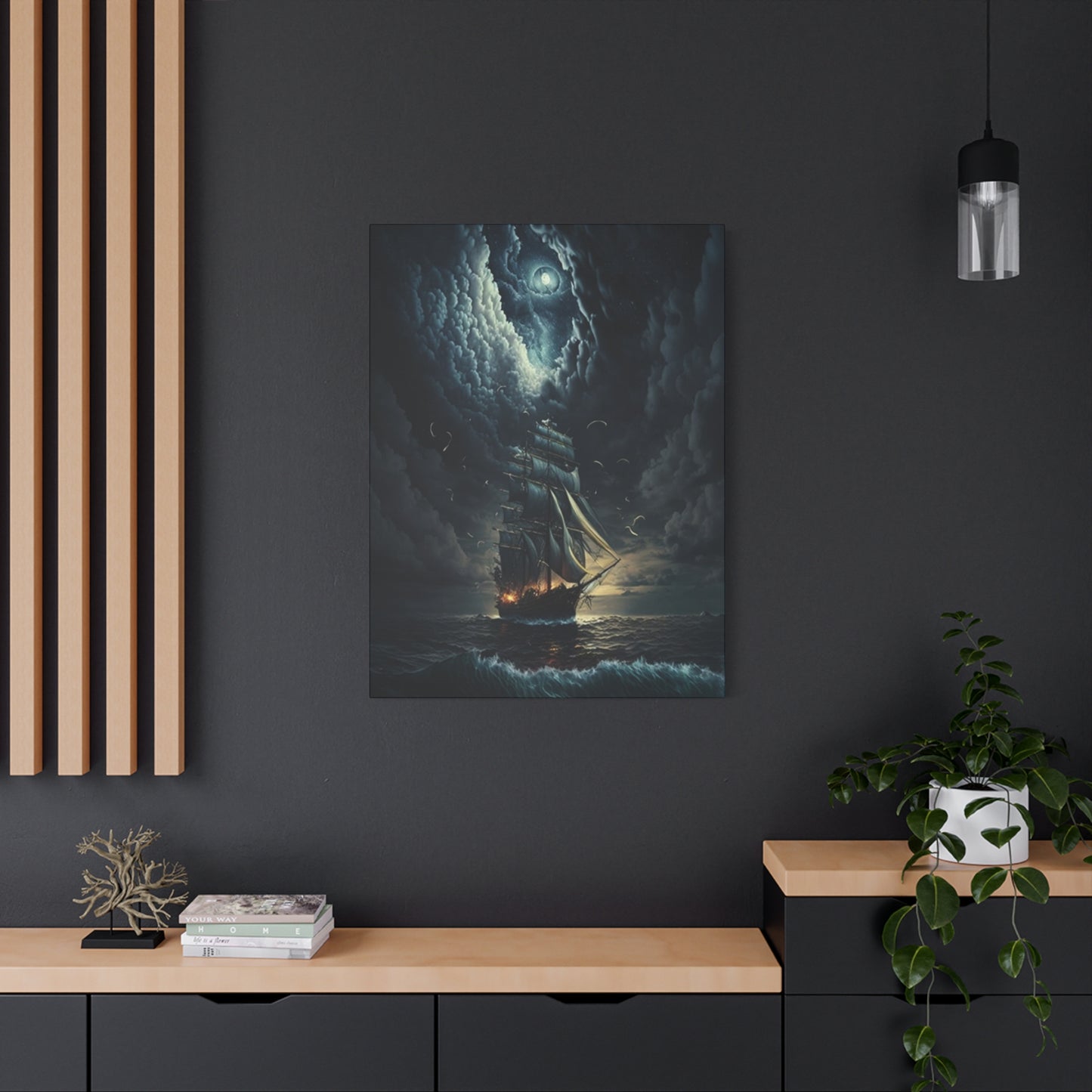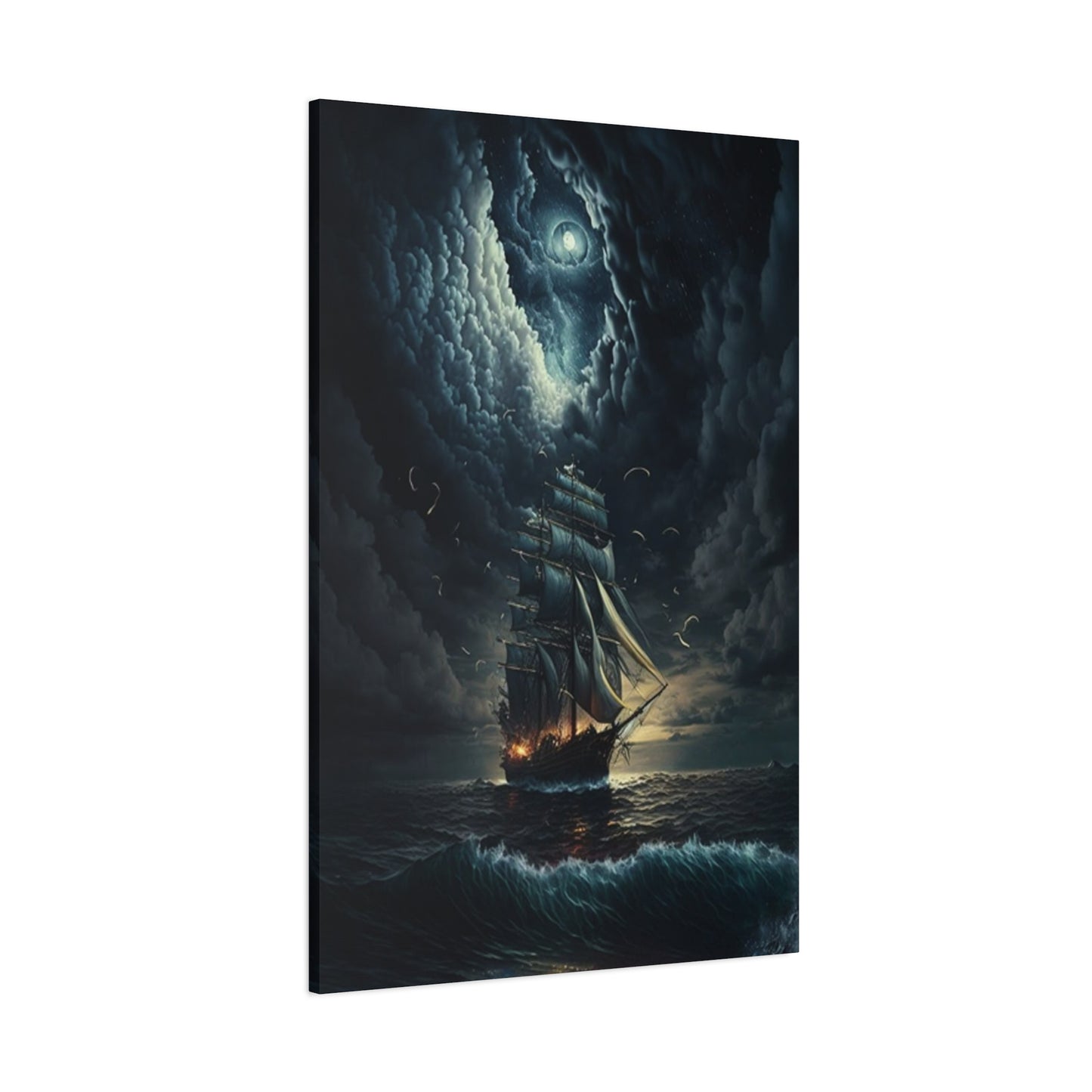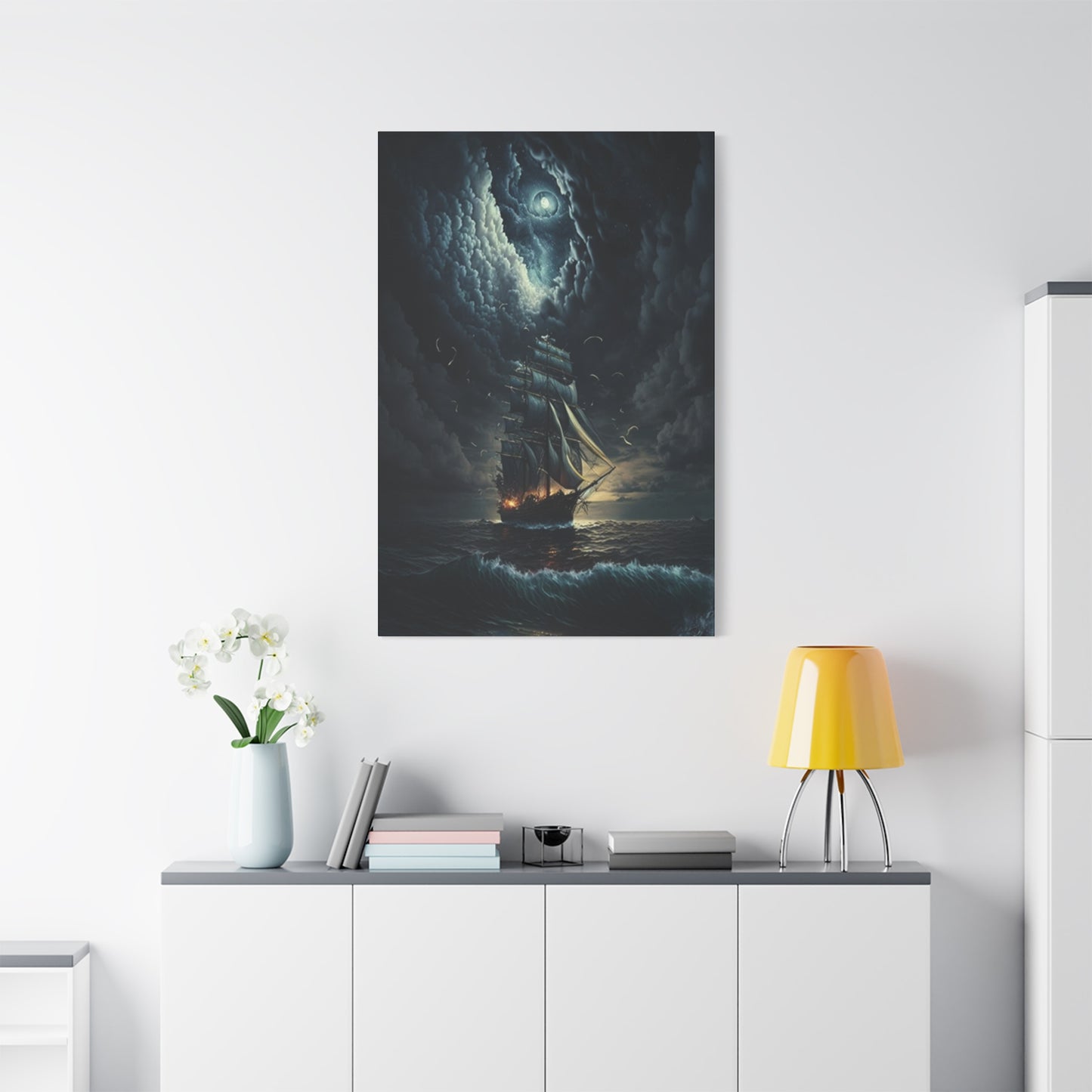Nocturnal Voyage: Ship Sailing Night Wall Art for Contemporary Interiors
The fascination with maritime artwork has captivated art enthusiasts and interior designers for centuries, with ship sailing at night painting wall art canvas prints representing one of the most evocative categories within this genre. These stunning visual compositions capture the mysterious allure of vessels navigating through darkened waters, illuminated by moonlight, stars, or the warm glow of lanterns. The emotional depth conveyed through nocturnal maritime scenes creates an atmosphere of adventure, contemplation, and romantic nostalgia that resonates deeply with contemporary audiences.
Maritime paintings depicting ships under nighttime conditions offer viewers a unique perspective on seafaring life, showcasing the courage and determination required to traverse open waters in darkness. The contrast between the illuminated vessel and the surrounding shadows creates dramatic visual tension that draws the eye and stimulates imagination. Canvas prints featuring these themes have become increasingly popular among homeowners, office designers, and commercial space decorators who seek to infuse their environments with a sense of history, adventure, and artistic sophistication.
The artistic representation of ships sailing through night waters encompasses various styles, from classical realism to impressionistic interpretations and modern abstract renditions. Each approach brings its own character to the subject matter, allowing collectors to select pieces that align with their personal aesthetic preferences and interior design schemes. Whether rendered in oil painting reproductions or contemporary digital art formats, these maritime masterpieces continue to enchant viewers with their ability to transport observers to distant shores and bygone eras.
Historical Significance of Maritime Nocturnal Artwork
The tradition of depicting ships at night has deep roots in art history, with master painters from various periods exploring the interplay of light and shadow on water surfaces. Early maritime artists recognized the dramatic potential of nocturnal scenes, where limited light sources created opportunities for exploring chiaroscuro techniques and atmospheric effects. These historical works established a visual language that contemporary canvas print manufacturers continue to reference and reinterpret for modern audiences.
During the Age of Sail, paintings showing vessels navigating through darkness served both documentary and romantic purposes. They recorded the reality of maritime life while simultaneously romanticizing the adventurous spirit of seafaring communities. Artists captured the technical details of ship construction alongside the emotional experience of ocean travel, creating works that appealed to both sailors and landlocked viewers. This dual function ensured that maritime night scenes maintained relevance across different social classes and geographic regions.
The development of canvas printing technology has democratized access to these historically significant images, allowing art lovers to display reproductions of famous maritime paintings alongside contemporary interpretations. This accessibility has sparked renewed interest in nautical themes, with ship sailing at night painting wall art canvas prints becoming staple elements in residential and commercial interior design projects. The historical resonance of these images adds layers of meaning to contemporary spaces, connecting modern environments with maritime heritage and seafaring traditions.
Artistic Techniques in Nocturnal Maritime Paintings
Creating compelling nocturnal maritime artwork requires mastery of specific artistic techniques that capture the unique qualities of night scenes on water. Artists working in this genre must skillfully balance light sources, render reflective water surfaces, and create atmospheric depth that conveys the vast expanse of open ocean. The technical challenges inherent in depicting darkness while maintaining visual interest and readability have inspired innovative approaches across different artistic movements and time periods.
Light source management represents one of the most critical aspects of nocturnal maritime painting. Artists must carefully consider how moonlight, starlight, ship lanterns, and other illumination sources interact with the vessel, water, and sky. The subtle gradations between illuminated and shadowed areas create the dramatic tension that defines successful night maritime scenes. Skilled artists use this contrast to direct viewer attention, establish mood, and convey narrative elements within the composition.
Color palette selection plays an equally important role in creating authentic nocturnal maritime atmospheres. While darkness naturally limits color range, artists employ carefully chosen blues, grays, blacks, and occasional warm tones to suggest depth and dimension. The interplay between cool nighttime hues and warm artificial light creates visual interest and emotional resonance. Modern canvas print reproduction techniques have advanced to the point where these subtle color relationships translate effectively to printed media, preserving the artistic intent of original paintings.
Texture and brushwork contribute significantly to the overall impact of ship sailing night scenes. Rough seas demand energetic, dynamic brushstrokes that convey movement and power, while calm waters require smoother, more reflective surfaces. The vessel itself needs detailed rendering to maintain credibility, with rigging, sails, and hull details carefully observed and depicted. Contemporary canvas printing processes can capture these textural qualities, reproducing the dimensional aspects of original paintings through advanced ink layering and surface treatment technologies.
Choosing the Perfect Ship Sailing Night Canvas Print
Selecting the ideal ship sailing at night painting wall art canvas prints for your space involves considering multiple factors that influence both aesthetic impact and practical suitability. The first consideration involves understanding your existing interior design scheme and identifying how maritime artwork can enhance or complement current decorative elements. Nautical themes work exceptionally well in various settings, from coastal homes to urban apartments, provided the specific artwork aligns with the overall design vision.
Size selection represents a crucial decision point when acquiring canvas prints. Large-scale maritime paintings create dramatic focal points that anchor entire rooms, while smaller pieces work effectively in gallery wall arrangements or accent positions. Consider the wall space available, viewing distance, and surrounding furniture when determining appropriate dimensions. Oversized canvas prints depicting ships at night can transform bland walls into captivating visual experiences, while modestly sized pieces allow for more flexible arrangement options and easier relocation.
Color coordination between the canvas print and existing room elements ensures cohesive visual harmony. Nocturnal maritime scenes naturally incorporate blues, grays, and dark tones that pair beautifully with neutral color schemes, but the specific hues within the artwork should complement rather than clash with wall colors, furniture upholstery, and decorative accents. Some ship sailing night paintings feature warmer color palettes emphasizing amber lamplight or sunset remnants, which coordinate effectively with wood tones and earth-inspired interior designs.
Artistic style selection allows collectors to express personal taste while maintaining design consistency. Classical realistic depictions appeal to traditionalists and history enthusiasts, while impressionistic interpretations offer softer, more atmospheric qualities. Modern and abstract approaches to maritime night scenes provide contemporary edge suitable for minimalist or industrial-inspired spaces. Mixed-media collage treatments and digital art interpretations expand the range of available styles, ensuring options exist for every aesthetic preference.
Frame selection and mounting options significantly impact the final presentation of ship sailing canvas prints. Gallery-wrapped canvases without visible frames create clean, modern appearances that suit contemporary interiors, while traditionally framed pieces add formal elegance appropriate for classic design schemes. Consider whether the artwork will hang alone or as part of a grouped arrangement, as this influences frame style choices and coordination requirements.
Popular Maritime Night Scene Compositions
Several compositional approaches recur throughout ship sailing at night painting wall art canvas prints, each offering distinct visual and emotional qualities. Single vessel compositions focus attention on one ship navigating through darkness, emphasizing the solitary courage of seafarers confronting vast oceans. These centered subjects create strong focal points that work particularly well in spaces requiring dominant visual anchors, such as living room feature walls or office reception areas.
Multiple ship compositions depicting fleets or naval encounters add narrative complexity and historical context to maritime night scenes. These busier arrangements suit larger spaces where detailed viewing from various distances enhances appreciation. Fleet scenes often incorporate additional elements like distant shorelines, lighthouses, or harbor structures that expand the storytelling possibilities and create layered visual interest.
Storm-tossed vessels battling rough seas represent dramatic high-tension compositions that inject energy and movement into interior spaces. These dynamic scenes feature tilted ship angles, turbulent waves, and atmospheric conditions that convey struggle and determination. While intense, these compositions paradoxically create calming effects by externalizing internal tensions and providing contemplative focus for viewers.
Calm moonlit scenes showing peaceful night sailing offer serene alternatives that promote relaxation and tranquility. These compositions typically feature still waters reflecting celestial light, with ships gliding smoothly across glassy surfaces. The contemplative quality of peaceful maritime night scenes makes them excellent choices for bedrooms, reading rooms, and meditation spaces where calming atmospheres support specific activities.
Harbor and port scenes depicting ships at anchor during nighttime hours combine maritime elements with architectural features and human activity. These compositions provide rich detail and storytelling opportunities, showing the intersection between seafaring life and land-based communities. The inclusion of buildings, docks, and figures adds contextual information that helps viewers connect with historical periods and maritime cultures.
Canvas Print Quality Considerations
Understanding quality factors in ship sailing at night painting wall art canvas prints ensures investment in artwork that maintains visual appeal and structural integrity over extended periods. Canvas substrate selection forms the foundation of print quality, with tightly woven cotton and polyester blends offering optimal surface texture and dimensional stability. Museum-quality canvases resist sagging, warping, and degradation, preserving artwork appearance despite environmental fluctuations.
Ink technology significantly impacts color accuracy, vibrancy, and longevity in maritime canvas prints. Archival pigment-based inks resist fading from light exposure and environmental factors far better than dye-based alternatives. UV-resistant ink formulations extend the displayable lifespan of ship sailing night canvases, particularly important for artwork placed in naturally lit rooms. Inquire about ink specifications when purchasing maritime canvas prints to ensure long-term color stability.
Print resolution determines fine detail reproduction and overall image sharpness in maritime canvases. High-resolution printing processes capture subtle gradations in nocturnal skies, intricate ship rigging details, and textural qualities of water surfaces. Lower-resolution prints appear soft or blurry upon close inspection, diminishing the sophisticated impact that maritime artwork should provide. Verify that canvas print manufacturers use professional-grade printing equipment capable of producing gallery-quality results.
Coating and finishing treatments protect canvas surfaces while enhancing visual properties. Protective varnishes shield maritime prints from dust accumulation, moisture damage, and minor impacts without significantly altering appearance. Matte finishes reduce glare and maintain traditional painting aesthetics, while satin finishes add subtle luster that enhances color depth. Glossy finishes maximize color vibrancy but increase glare visibility in brightly lit environments.
Stretching and mounting techniques influence both visual presentation and structural longevity of maritime canvas prints. Gallery-wrap stretching pulls canvas around wooden frames, creating finished edges that eliminate traditional framing requirements. Standard stretching leaves visible canvas staples on sides, necessitating frame coverage but reducing costs. Properly tensioned canvas prevents sagging and rippling that compromise professional appearance.
Caring for Maritime Canvas Artwork
Proper maintenance extends the lifespan and preserves the visual quality of ship sailing at night painting wall art canvas prints. Dust accumulation represents the primary ongoing concern, as airborne particles settle on canvas surfaces and dull color vibrancy. Regular gentle dusting using soft, dry microfiber cloths removes surface debris without abrading protective coatings. Avoid feather dusters, which can snag canvas textures and potentially damage surfaces.
Light exposure management prevents premature fading and color shifting in maritime canvas prints. Position artwork away from direct sunlight, particularly during peak intensity hours when UV radiation reaches maximum levels. If window proximity is unavoidable, install UV-filtering window films or use protective glass covers that block harmful wavelengths while maintaining visual clarity. Rotate displayed artwork periodically if maintaining collections, allowing pieces to rest in storage where light exposure causes no damage.
Humidity control preserves canvas dimensional stability and prevents mold growth on maritime artwork. Maintain indoor relative humidity between forty and sixty percent, which protects both canvas materials and wooden stretcher bars. Excessive humidity causes canvas sagging and promotes mold development, while insufficient moisture makes materials brittle and prone to cracking. Use dehumidifiers in damp climates and humidifiers in arid regions to maintain optimal conditions.
Temperature stability prevents expansion and contraction cycles that stress canvas materials and mounting hardware. Avoid hanging ship sailing night canvases near heating vents, air conditioning outlets, or fireplaces where temperature fluctuations occur frequently. Consistent environmental conditions preserve adhesive bonds, prevent warping, and maintain even canvas tension across stretched surfaces.
Physical damage prevention requires conscious placement decisions and household awareness. Hang maritime canvas prints at appropriate heights that prevent contact with furniture, foot traffic, or playful pets. In high-traffic areas, position artwork slightly higher than standard eye level to reduce accidental impact risks. Consider protective plexiglass covers for valuable pieces in households with young children or in commercial settings where public interaction increases damage probability.
Professional cleaning becomes necessary when dust accumulation exceeds surface maintenance capabilities or when stains compromise appearance. Contact art conservation specialists rather than attempting aggressive cleaning, as improper techniques can permanently damage canvas prints. Professionals possess specialized tools and knowledge for safely treating maritime artwork without causing color bleeding, surface abrasion, or coating removal.
Decorating Styles That Complement Maritime Artwork
Ship sailing at night painting wall art canvas prints adapt successfully to numerous interior design styles, though certain aesthetic approaches create particularly harmonious relationships. Coastal and nautical design schemes naturally embrace maritime artwork, with ship sailing night scenes reinforcing thematic consistency throughout spaces. Combine maritime canvases with rope accents, weathered wood furnishings, and blue-and-white color palettes to create cohesive coastal atmospheres that evoke seaside living regardless of actual geographic location.
Traditional and classic interior styles benefit from historically inspired maritime paintings that reference golden age sailing eras. Pair ornately framed ship sailing night canvases with antique furniture, oriental rugs, and rich wood paneling to create sophisticated traditional environments. The formal elegance of classical maritime artwork elevates traditional spaces while providing visual interest that prevents stuffiness.
Modern and contemporary interiors surprisingly accommodate maritime night scenes when selecting appropriately styled artwork. Abstract interpretations of ship sailing themes, minimalist compositions, or black-and-white maritime photography align with modern design principles emphasizing clean lines and restrained ornamentation. Large-scale contemporary maritime canvases create dramatic focal points in minimalist spaces where limited decorative elements receive maximum attention.
Industrial design schemes incorporating exposed brick, metal elements, and utilitarian furnishings gain unexpected softness through maritime artwork additions. The historical character of ship sailing night paintings provides counterbalance to industrial hardness while maintaining authentic vintage qualities that complement industrial aesthetics. Choose maritime canvases with darker tones and dramatic compositions that match the edgy intensity of industrial environments.
Transitional design bridging traditional and contemporary styles finds ideal artistic expression through maritime night scenes. These versatile artworks possess historical gravitas appealing to traditional sensibilities alongside timeless compositional qualities that suit contemporary tastes. Neutral frame selections and moderate sizing allow transitional maritime canvases to adapt as design preferences evolve.
Eclectic and bohemian interiors benefit from maritime artwork's ability to anchor diverse decorative collections. Ship sailing night canvases provide stable visual reference points around which varied accessories, textiles, and furniture styles can orbit. The narrative richness of maritime scenes supports eclectic design philosophy celebrating collected objects and personal histories.
Size Selection for Different Spaces
Determining appropriate dimensions for ship sailing at night painting wall art canvas prints requires careful evaluation of room proportions, wall dimensions, and furniture scale. Small spaces including powder rooms, hallways, and compact offices accommodate maritime canvases ranging from sixteen by twenty inches to twenty-four by thirty-six inches. These modest dimensions provide visual interest without overwhelming limited wall space, maintaining comfortable visual proportions in confined areas.
Medium-sized rooms such as standard bedrooms, dining rooms, and home offices support maritime canvas prints measuring thirty by forty inches to forty-eight by sixty inches. These intermediate dimensions create substantial visual presence without dominating entire walls, leaving space for additional decorative elements and maintaining balanced compositions. Medium maritime canvases work effectively as standalone statements or within gallery wall arrangements incorporating multiple pieces.
Large living rooms, great rooms, and open-concept spaces demand oversized maritime artwork measuring sixty by eighty inches or larger. These dramatic canvases command attention and anchor expansive walls that smaller pieces would fail to address adequately. Oversized ship sailing night paintings create luxury hotel or gallery-like atmospheres in residential settings, transforming ordinary rooms into distinctive spaces with memorable character.
Vertical versus horizontal orientation selection influences perceived space dimensions and visual flow. Horizontal maritime canvases emphasize width and create calming, stable compositions suitable for placement above sofas, beds, and sideboards. Vertical orientations draw eyes upward, making ceilings appear higher while suiting narrow wall sections between windows or in hallway installations. Square formats offer versatile compromise options that adapt to various placement scenarios.
Multi-panel arrangements provide flexible sizing alternatives to single large canvases. Triptych ship sailing night compositions split scenes across three connected panels, creating contemporary presentations of traditional maritime subjects. These segmented arrangements accommodate larger total dimensions while remaining manageable for shipping, handling, and installation. Gaps between panels add modern design elements that distinguish multi-panel presentations from traditional single-canvas approaches.
Creating Gallery Wall Arrangements
Incorporating ship sailing at night painting wall art canvas prints into gallery wall displays allows collectors to showcase multiple maritime pieces while creating dynamic visual compositions. Symmetrical arrangements featuring identically sized maritime canvases create formal, organized presentations suitable for traditional interiors. Grid layouts with evenly spaced ship sailing prints provide clean, gallery-like aesthetics that emphasize individual artwork while maintaining unified groupings.
Asymmetrical gallery walls mixing various maritime canvas sizes create casual, collected appearances suggesting organic acquisition over time. These freestyle arrangements feel personal and lived-in rather than professionally staged, making spaces more inviting and authentic. Balance asymmetrical compositions by distributing visual weight evenly across arrangement areas, preventing lopsided appearances where one section dominates attention.
Thematic gallery walls featuring exclusively maritime night scenes create immersive environments celebrating seafaring subjects. Combining different ship types, time periods, and artistic styles within nautical themes maintains visual variety while preserving cohesive subject matter. Viewers enjoy comparing interpretations and discovering details across multiple related pieces.
Mixed-theme gallery walls incorporate maritime canvases alongside complementary subjects including coastal landscapes, marine life, navigational instruments, and historical maps. These expanded arrangements provide contextual richness that deepens maritime artwork impact through associated imagery. Ensure color coordination and stylistic consistency when mixing subjects to prevent chaotic, disjointed appearances.
Salon-style gallery walls featuring dense arrangements of varied-size maritime canvases create maximalist displays with European gallery character. These ambitious installations require careful planning to achieve balanced compositions despite irregular spacing and size variations. Salon arrangements transform entire walls into artistic focal points that dominate room character and demand attention.
Linear gallery walls arranging ship sailing night canvases in horizontal rows create contemporary presentations with architectural precision. These structured layouts work particularly well in hallways, stairwells, and above lengthy furniture pieces like console tables. Maintain consistent spacing between frames and align top or bottom edges to achieve clean, professional linear arrangements.
Maritime Artwork in Commercial Spaces
Ship sailing at night painting wall art canvas prints enhance various commercial environments by creating sophisticated atmospheres that positively influence customer experiences and employee satisfaction. Restaurant and hospitality venues benefit from maritime artwork establishing distinctive character that differentiates establishments from competitors. Nautical themes particularly suit seafood restaurants, coastal resorts, and waterfront properties where thematic consistency reinforces brand identity and location awareness.
Corporate office maritime canvases project professionalism, stability, and adventurous vision appropriate for business environments. Ship sailing night scenes symbolize navigation through challenges, strategic planning, and successful journey completion—metaphors that resonate with business objectives. Conference rooms and executive offices gain gravitas through carefully selected maritime artwork that impresses clients while inspiring employees.
Medical and dental practices reduce patient anxiety through calming maritime artwork that provides contemplative focal points during stressful appointments. The tranquil qualities of moonlit ship sailing scenes help patients relax while waiting, creating more positive associations with medical environments. Coastal-themed medical practices find particular success with maritime decorative programs that reinforce calming seaside atmospheres.
Retail environments use maritime canvas prints to establish brand identity and create memorable shopping experiences. Nautical-themed boutiques, home goods stores, and lifestyle retailers incorporate ship sailing artwork that reinforces product offerings and target market expectations. Well-chosen maritime pieces contribute to overall store aesthetics that encourage browsing and increase time spent in retail spaces.
Educational institutions including maritime academies, history departments, and library study areas benefit from maritime artwork's educational value alongside aesthetic contributions. Ship sailing night paintings illustrate historical contexts, inspire exploration interests, and create environments conducive to learning and research. These institutional applications combine decorative and pedagogical functions that justify artwork investments through multiple value propositions.
Customization Options for Maritime Canvas Prints
Personalization opportunities allow collectors to create unique ship sailing at night painting wall art canvas prints tailored to specific preferences and requirements. Custom sizing ensures maritime canvases fit precisely within available wall spaces, eliminating compromise between standard dimensions and actual needs. Specify exact measurements to maximize visual impact in unusually proportioned spaces or to achieve perfect coordination with existing architectural features.
Color modification services adjust maritime painting palettes to coordinate with established interior color schemes. Professional colorization transforms monochrome maritime images into custom-toned pieces matching specific design requirements. Hue shifting modifies existing color paintings to emphasize particular tones, creating harmonious relationships with wall colors, furnishings, and decorative accessories.
Text overlay options add personalized messages, names, dates, or quotes to maritime canvas prints, creating commemorative pieces celebrating significant events or honoring maritime heritage. Anniversary dates, family names, or inspirational seafaring quotes integrated tastefully into maritime compositions transform standard artwork into meaningful personal statements. Ensure text additions complement rather than overwhelm underlying maritime imagery.
Image combination services merge multiple maritime elements into unified custom compositions. Combine specific ship types with preferred backgrounds, add family-significant maritime locations, or integrate personal nautical photography with painted elements. These bespoke creations result in truly unique maritime artwork unavailable through standard offerings.
Lighting Design for Maritime Canvas Displays
Proper illumination significantly enhances the visual impact of ship sailing at night painting wall art canvas prints while protecting artwork from light-induced damage. Picture lighting systems featuring adjustable LED fixtures mounted above maritime canvases provide focused illumination that highlights artwork without excessive heat or UV emission. Modern LED picture lights offer energy efficiency, longevity, and precise color temperature control that preserves maritime print quality.
Track lighting installations create flexible illumination schemes accommodating multiple maritime canvases or adaptable arrangements. Adjustable track heads direct light precisely where needed, emphasizing key compositional elements within ship sailing night scenes. Dimmer controls allow lighting intensity adjustment based on time of day, natural light availability, and desired ambiance levels.
Recessed ceiling spotlights provide unobtrusive maritime artwork illumination that maintains clean architectural lines in contemporary interiors. Position recessed fixtures at appropriate angles preventing glare on canvas surfaces while achieving even light distribution across entire artworks. Calculate proper distance and angle relationships between recessed lights and maritime canvases to avoid hot spots or shadowed areas.
Ambient room lighting affects maritime canvas appearance as significantly as dedicated artwork illumination. Balance general lighting levels to prevent excessive brightness washing out nocturnal scene subtleties. Layered lighting schemes combining ambient, task, and accent lighting create sophisticated environments where maritime artwork receives appropriate emphasis without competing with other light sources.
Popular Ship Types in Maritime Night Paintings
Clipper ships with their distinctive hull designs and extensive sail configurations appear frequently in ship sailing at night painting wall art canvas prints due to their elegant profiles and historical significance. These fast sailing vessels dominated trade routes during the nineteenth century, representing the pinnacle of commercial sailing ship development. Clipper ship nocturnal paintings capture both technical beauty and romantic seafaring era nostalgia appealing to maritime art collectors.
Tall ships featuring multiple masts and complex rigging create visually impressive maritime compositions filled with intricate details. These majestic vessels showcase sailing technology sophistication while providing artists abundant opportunities for demonstrating technical skill. Tall ship night scenes work particularly well in large-format canvas prints where rigging details remain visible and compositional complexity justifies expanded viewing.
Naval warships including frigates, ships-of-the-line, and battleships introduce historical drama and national pride themes into maritime night paintings. These powerful vessels represent military might and strategic importance, appealing to history enthusiasts and veterans. Warship nocturnal scenes often depict naval battles or patrol missions, adding narrative elements that enhance viewer engagement and emotional connection.
Fishing vessels and working boats bring authentic maritime labor perspectives to canvas prints. These practical craft represent everyday seafaring life rather than romantic exploration or military glory. Fishing boat night paintings appeal to viewers valuing authenticity and connection to maritime industry realities. The weathered character of working vessels provides artistic texture and documentary interest distinct from pristine recreational or military ships.
Schooners with their characteristic fore-and-aft rigging offer streamlined profiles well-suited to artistic composition. These versatile sailing vessels served various purposes from fishing to cargo transport, making them familiar subjects with broad appeal. Schooner night paintings often emphasize graceful lines and efficient sailing characteristics that made these designs popular throughout maritime history.
Pirate and privateer vessels inject adventure and outlaw mystique into maritime canvas prints. These romanticized subjects appeal to imagination and storytelling interests, creating conversation pieces with narrative potential. Pirate ship night scenes often emphasize danger, treasure-seeking, and freedom themes that resonate with viewers seeking escapist artwork.
Seasonal Considerations for Maritime Artwork
Ship sailing at night painting wall art canvas prints adapt successfully to seasonal decorating rotations that refresh interior appearances throughout the year. Winter maritime displays emphasizing stormy seas and dramatic weather conditions complement seasonal atmospheres featuring darker days and inclement outdoor conditions. These intense maritime scenes harmonize with winter's introspective character while providing contemplative focal points during indoor-focused months.
Spring maritime rotations might feature calmer ship sailing night scenes suggesting renewed adventure possibilities as weather improves. Lighter-toned nocturnal paintings with clearer skies reflect spring's optimistic character and lengthening daylight. Transitioning from winter storm scenes to spring calm maritime canvases creates decorative narrative paralleling natural seasonal progressions.
Summer maritime artwork selections often emphasize warm evening scenes with golden sunset remnants or tropical night sailing conditions. These vacation-inspired maritime canvases reinforce summer's leisurely character and outdoor recreation associations. Summer maritime displays transport viewers to coastal destinations and seafaring adventures aligned with seasonal travel traditions.
Autumn maritime paintings featuring moodier atmospheric conditions and transitional lighting suit fall's contemplative character. Nocturnal scenes with amber ship lighting and darkening skies echo autumn's shortening days and approaching winter. Fall maritime displays create cozy atmospheres appropriate for increased indoor time as temperatures cool.
Digital versus Traditional Maritime Canvas Prints
Technology evolution has created distinct categories within ship sailing at night painting wall art canvas prints, with digital and traditional printing methods producing different aesthetic results. Traditional canvas prints reproduce existing paintings through photographic or scanning processes, capturing original artworks created through conventional media. These reproductions maintain direct connections to art historical traditions and often feature visible brushwork textures that reference original painting techniques.
Digital maritime art creation employs computer software and digital illustration tools to generate original compositions without physical paint media. These contemporary approaches enable artistic effects impossible through traditional methods, including perfect symmetry, complex layering, and precise detail control. Digital maritime night scenes appeal to modern aesthetic sensibilities while offering practical advantages including easy modification and infinite reproduction without quality degradation.
Hybrid approaches combining traditional painting foundations with digital enhancement represent increasingly common middle grounds. Artists create physical maritime paintings subsequently scanned and digitally refined, correcting imperfections while preserving authentic painting character. These hybrid processes balance traditional authenticity with digital precision, producing maritime canvases satisfying diverse collector preferences.
Textural reproduction capabilities differ significantly between printing technologies, affecting final maritime canvas appearances. Advanced giclée printing processes layer inks creating dimensional surface qualities approximating original brushwork. Economy printing methods produce flatter results lacking textural depth, though remaining visually effective from normal viewing distances. Texture preferences vary among collectors, with some valuing smooth contemporary finishes while others prefer traditional painting texture simulation.
Environmental Considerations in Canvas Print Production
Sustainability concerns increasingly influence ship sailing at night painting wall art canvas prints manufacturing processes, with environmentally conscious producers adopting eco-friendly materials and methods. Canvas substrate sourcing from organic cotton or recycled polyester reduces environmental footprints compared to conventional material production. These sustainable canvas options perform identically to traditional materials while supporting environmental responsibility goals important to conscious consumers.
Water-based ink formulations eliminate toxic solvent emissions associated with traditional printing inks, creating healthier production environments and reducing atmospheric pollution. These eco-friendly inks deliver color quality matching solvent-based alternatives while biodegrading naturally without releasing harmful chemicals. Maritime canvas prints produced using water-based inks appeal to environmentally aware collectors seeking sustainable decorating options.
Energy-efficient printing equipment reduces carbon footprints associated with maritime canvas production. Modern LED-cured printing systems consume substantially less electricity than conventional drying methods while accelerating production speeds. These efficiency improvements benefit both environmental sustainability and consumer costs through reduced operational expenses passed through pricing.
Packaging material selection impacts maritime canvas print environmental profiles, with recyclable and biodegradable options replacing traditional plastic packaging. Cardboard tubes, paper wrapping, and plant-based protective materials provide adequate shipping protection while decomposing naturally after disposal. Minimal packaging approaches reduce waste generation without compromising product protection during shipping and handling.
Local production facilities minimize transportation-related emissions by reducing distances between manufacturing locations and consumer markets. Regionally produced maritime canvases support local economies while decreasing fossil fuel consumption associated with long-distance shipping. Consumers increasingly value locally manufactured artwork supporting community businesses and environmental goals simultaneously.
Waste reduction programs within maritime canvas print facilities recycle production scraps, reuse materials, and minimize overall waste generation. Responsible manufacturers implement comprehensive sustainability programs addressing energy consumption, material sourcing, waste management, and employee practices. These holistic approaches create genuinely sustainable maritime canvas production processes rather than superficial greenwashing marketing.
Maritime Canvas Prints in Themed Interior Design
Ship sailing at night painting wall art canvas prints anchor comprehensive nautical design schemes extending throughout entire rooms or homes. Coordinated color palettes drawing from maritime canvas hues create cohesive environments where walls, furnishings, and accessories harmonize around seafaring themes. Navy blues, crisp whites, weathered grays, and natural wood tones extracted from maritime paintings inform broader decorating decisions creating unified aesthetic visions.
Textile selections echoing maritime themes reinforce nautical design consistency established by ship sailing canvas prints. Striped patterns referencing sailor uniforms, rope-textured fabrics, and anchor-motif pillows complement maritime artwork while extending nautical character beyond wall surfaces. These coordinated soft goods create layered thematic depth that transforms ordinary rooms into immersive maritime environments.
Furniture choices supporting maritime themes include weathered wood pieces suggesting shipboard construction, rope-wrapped elements, and maritime blue upholstery. Distressed finishes on furniture coordinate with historical character present in traditional ship sailing night paintings, while cleaner contemporary furniture aligns with modern maritime interpretations. Furniture selection offers opportunities for either reinforcing or contrasting maritime canvas styles depending on desired overall effects.
Decorative accessories including nautical instruments, ship models, marine rope, and maritime books extend seafaring themes introduced by canvas prints. These three-dimensional objects add authenticity and interest while preventing maritime designs from appearing one-dimensional or superficial. Careful accessory curation prevents overwhelming spaces with excessive nautical kitsch, maintaining sophisticated maritime atmospheres rather than theme-park aesthetics.
Historical Maritime Events in Canvas Art
Ship sailing at night painting wall art canvas prints depicting specific historical maritime events offer educational value alongside aesthetic appeal, documenting significant moments in seafaring history. Famous naval battles rendered in nocturnal settings capture dramatic military encounters that shaped national destinies and international relations. These historically significant maritime canvases appeal to history enthusiasts and military collectors seeking artwork with documented educational content.
Exploration voyages featuring pioneering ships navigating uncharted waters celebrate human curiosity and courage. Maritime night paintings showing expedition vessels represent discovery eras when seafaring expanded geographic knowledge and cultural exchange. These exploration-themed canvases inspire contemporary viewers while honoring historical adventurers whose courage enabled global civilization development.
Trade route establishment depicted through merchant vessel paintings documents commercial maritime activities that created global economic networks. These working ship night scenes show practical seafaring applications beyond military or exploration contexts, recognizing maritime commerce importance throughout history. Trade vessel paintings appeal to business professionals and economic history enthusiasts appreciating commercial maritime contributions.
Rescue operations and humanitarian maritime missions provide uplifting subject matter emphasizing seafaring community values and mutual assistance traditions. Ships responding to distress calls, lighthouse keeper stories, and coast guard rescues celebrate selfless service and maritime solidarity. These positive maritime narratives appeal to viewers seeking hopeful, affirming artwork rather than conflict-focused subjects.
Immigration journeys showing passenger vessels carrying emigrants toward new lives combine maritime subject matter with human interest stories. These poignant maritime night scenes acknowledge displacement hardships while celebrating hope and new beginning possibilities. Immigration ship paintings resonate with viewers having family maritime migration histories, creating personal connections with artwork subjects.
Technological advancement milestones including first steamship voyages, innovative vessel designs, and maritime engineering achievements document nautical innovation progress. These technically focused maritime paintings appeal to engineering enthusiasts and technology historians appreciating human ingenuity applied to seafaring challenges. Technological maritime subjects bridge artistic and scientific interests attracting diverse collector demographics.
Regional Maritime Art Styles
Ship sailing at night painting wall art canvas prints reflect diverse regional artistic traditions developed in maritime communities worldwide, each bringing distinctive characteristics and cultural perspectives. Mediterranean maritime art emphasizes warm color palettes, ancient vessel types, and classical compositional approaches reflecting southern European artistic traditions. These sun-soaked regional styles contrast with northern maritime art even when depicting nocturnal scenes through underlying warmth and light quality.
Northern European maritime paintings feature cooler tones, stormy atmospheric conditions, and dramatic lighting reflecting harsh seafaring environments characterizing Atlantic and North Sea regions. Dutch and Flemish maritime traditions particularly influenced nocturnal ship painting development through technical mastery of light, shadow, and atmospheric perspective. These northern styles convey seafaring's serious, dangerous nature through compositional choices and color relationships.
Asian maritime art traditions bring unique perspectives to ship sailing night themes through distinctive vessel types, cultural symbolism, and non-Western compositional principles. Chinese junk ships, Japanese coastal vessels, and Southeast Asian traditional craft appear in regional maritime artwork offering alternatives to European ship dominance. These cultural variations enrich maritime canvas print diversity while introducing collectors to global seafaring traditions.
American maritime painting traditions celebrate national naval history, commercial shipping development, and coastal community life through regionally distinctive approaches. New England maritime art differs from Gulf Coast traditions, which diverge from Pacific Northwest styles despite all addressing seafaring subjects. These American regional variations reflect geographic diversity and distinct maritime cultural developments across continental coastlines.
The Role of Moonlight in Maritime Compositions
Moonlight serves as the primary natural illumination source in ship sailing at night painting wall art canvas prints, creating distinctive atmospheric qualities that define nocturnal maritime aesthetics. Artists manipulate lunar light intensity, color temperature, and directional qualities to achieve varied emotional effects and compositional purposes. Full moon scenes provide maximum natural illumination enabling detailed ship rendering while maintaining nighttime character essential to nocturnal maritime compositions.
Crescent moon paintings create subtle, mysterious atmospheres with minimal natural light emphasizing artificial illumination sources aboard ships. These darker compositions heighten drama and emphasize human presence through contrast between small light sources and surrounding darkness. Crescent moon maritime scenes appeal to collectors preferring moody, contemplative artwork rather than brighter, more optimistic compositions.
Moonlight reflection on water surfaces represents technical and aesthetic focal points within maritime night paintings. Artists demonstrate skill through accurate rendering of lunar reflection behavior on calm versus rough waters, creating visual pathways leading toward ships. These reflective light paths serve compositional purposes guiding viewer attention while adding luminous beauty enhancing overall maritime scene appeal.
Cloud interaction with moonlight introduces atmospheric complexity and dramatic variation within nocturnal maritime compositions. Partially obscured moons create dynamic lighting conditions with shifting illumination patterns across scenes. These variable lighting situations increase compositional interest and suggest temporal progression within static images, implying ongoing weather pattern evolution.
Moonrise and moonset timing within maritime night scenes establishes temporal context and narrative implications. Low horizon moons suggest either early evening or predawn hours, while high overhead positions indicate midnight timeframes. These temporal cues influence viewer interpretation regarding journey stages, watch periods, and maritime operational contexts enhancing narrative depth.
Cultural moon symbolism enriches maritime night painting interpretation beyond pure aesthetic considerations. Lunar associations with cycles, navigation, feminine principles, and transformation add symbolic layers that resonate with viewers beyond surface visual appeal. These deeper meanings increase maritime canvas print significance for collectors appreciating multilayered artwork offering continued interpretive discovery.
Maritime Canvas Prints for Specific Professions
Ship sailing at night painting wall art canvas prints hold special significance for individuals in maritime-related professions who connect personally with seafaring imagery. Current and retired naval personnel often collect maritime artwork commemorating service experiences and maintaining connections to seafaring careers. These professional maritime collectors seek authentic vessel representations and historical accuracy reflecting genuine maritime knowledge.
Commercial mariners including cargo ship officers, cruise staff, and tanker crews appreciate maritime artwork acknowledging working seafaring realities beyond romantic adventure narratives. Realistic working vessel paintings resonate with professional sailors who lived experiences depicted in artwork. These maritime professionals often display ship paintings in homes as career tributes and conversation pieces explaining vocational backgrounds to visitors.
Marine industry professionals including shipbuilders, naval architects, and maritime engineers value technical accuracy and vessel design details in maritime canvas prints. These technically oriented collectors appreciate artwork showcasing construction details, rigging complexity, and engineering innovations. Maritime paintings satisfying professional technical standards gain enhanced significance when displayed in offices and homes of maritime industry experts.
Fishing industry workers and families maintain maritime artwork traditions honoring dangerous, essential work feeding global populations. Fishing vessel paintings acknowledge maritime labor contributions often overlooked in favor of military or recreational sailing subjects. These working maritime communities appreciate authentic representations honoring fishing heritage and contemporary industry continuation.
Port authority administrators, harbor masters, and maritime logistics professionals connect with harbor scene maritime paintings showing complex operational environments they manage professionally. These maritime compositions acknowledge shoreside maritime industry components essential to successful seafaring operations. Port-focused maritime artwork appeals to professionals understanding maritime activities extending beyond ship operations into comprehensive logistical networks.
Combining Maritime Art with Other Design Elements
Ship sailing at night painting wall art canvas prints integrate successfully with complementary decorative elements creating layered, sophisticated interior designs. Geographic coordination pairs maritime canvases with maps, globes, and navigation charts reinforcing exploration themes and geographic awareness. These combined elements create studious, intellectual atmospheres suitable for libraries, offices, and educational spaces.
Natural element combinations including driftwood, shells, coral, and beach stones complement maritime canvas prints through authentic coastal materials. These organic decorative objects reinforce nautical themes while adding textural variety and three-dimensional interest. Natural maritime elements prevent overly formal or stiff decorative schemes, introducing casual, collected characteristics.
Metallic accent coordination featuring brass, copper, and aged bronze reflects traditional maritime material palettes used in ship construction and navigation instruments. These metallic elements appear in lighting fixtures, decorative objects, and furniture hardware complementing maritime canvas prints through material authenticity. Metallic finishes add sophisticated glimmer contrasting with matte canvas surfaces creating visual interest through varied reflective properties.
Textile layering incorporating maritime-influenced fabrics builds comfort and warmth around ship sailing canvas focal points. Natural fiber textiles including linen, cotton, and jute reference sail materials and rope construction complementing maritime themes through material appropriateness. These textile additions soften hard surfaces and create inviting environments balanced between aesthetic appeal and comfortable functionality.
Vintage object integration featuring authentic maritime antiques, salvaged ship components, and period navigation instruments adds historical depth to spaces anchored by maritime canvas prints. These genuine artifacts lend authenticity preventing maritime designs from appearing superficial or commercialized. Antique maritime objects become conversation pieces supporting educational discussions about seafaring history and maritime heritage.
Plant selection incorporating coastal and maritime environment appropriate species strengthens connections between indoor maritime artwork and natural coastal ecosystems. Salt-tolerant plants, ornamental grasses, and species native to coastal regions reference maritime environments while adding living elements to interior spaces. These botanical choices complete holistic maritime design approaches engaging multiple senses beyond visual artwork appreciation.
Conclusion
Ship sailing at night painting wall art canvas prints represent far more than simple decorative objects, embodying rich artistic traditions, historical significance, and profound symbolic meanings that resonate across cultures and generations. These evocative maritime compositions capture the timeless human fascination with oceanic exploration, the romance of seafaring adventure, and the technical beauty of sailing vessels navigating through darkness. Whether rendered in classical realistic styles honoring artistic heritage or contemporary interpretations pushing creative boundaries, nocturnal maritime artwork maintains enduring appeal that transcends fleeting interior design trends.
The versatility of ship sailing canvas prints enables successful integration into virtually any residential or commercial environment, from coastal homes where nautical themes feel naturally appropriate to urban apartments where maritime artwork provides escapist windows into adventure and history. Through careful consideration of size, color relationships, artistic style, and placement strategies, these maritime masterpieces transform ordinary walls into captivating visual experiences that engage viewers and stimulate imagination. The psychological benefits of maritime artwork extend beyond aesthetic pleasure, offering calming influences, inspirational symbolism, and meaningful connections to maritime heritage that enrich daily living experiences.
Technological advances in canvas printing have democratized access to maritime artwork previously available only through original painting acquisition or expensive limited editions. Modern reproduction techniques preserve artistic integrity while making museum-quality maritime images affordable and accessible to broader audiences. Simultaneously, emerging technologies promise continued evolution in canvas printing capabilities, from enhanced textural reproduction to sustainable production methods addressing environmental concerns. These developments ensure maritime canvas prints remain relevant to artistic media adapting to contemporary values and technological possibilities.
The care and maintenance of maritime canvas prints requires modest effort yielding substantial long-term benefits through preserved appearance and extended display lifespans. Understanding proper environmental conditions, lighting considerations, and cleaning techniques protects investment value while ensuring continued aesthetic enjoyment. For collectors viewing maritime canvases as financial investments alongside decorative assets, attention to edition status, artist reputation, and documentation enhances both immediate satisfaction and potential future returns.
Beyond individual ownership enjoyment, maritime canvas prints serve educational functions preserving and transmitting seafaring heritage to new generations. These artistic vessels carry historical knowledge, cultural traditions, and technical information about maritime life across temporal distances, keeping seafaring legacies alive in contemporary consciousness. Whether depicting specific historical events, documenting vessel types, or celebrating maritime cultural contributions, ship sailing night paintings function as visual archives maintaining connections between present viewers and maritime pasts.


















